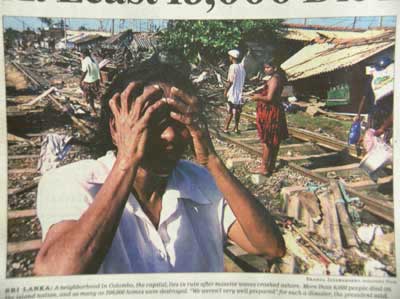Notes
Lost in the Waves

It’s seems ironic that Susan Sontag died Tuesday, just as waves and waves of images — professional and amateur — were pouring forth from the South Asian tsunami. Sontag was keenly interested in the function of photographs as cultural artifacts. From a political standpoint, she expressed concern that “picture taking” was both an aggressive and an imperial exercise. From a psychological perspective, she was concerned that the viewing of photographs had a tendency to give people a quick, easy and false sense that they had somehow experienced an event (and could, thus, more easily dismiss it).
A couple posts back, I commented on a front page news photo highlighting the bodies of dead Iraqi National Guard soldiers. One of my takes had to do with how explicit the picture was, and how the NYTimes seemed to be “upping the ante” in the depiction of corpses. I had a couple ideas about the shot, but I was primarily interested in it’s ability to produce an emotional reaction.
At the time, I also was confused about the picture’s effect on me. Or, more specifically, its lack of effect. Honestly, I felt guilty about this non-reaction, and looked (successfully, I believe) for aspects in the image which must have blunted my response. (Of course, little did I know that just a few weeks later, an enormous tragedy in Asia would open the door to even more explicit images of the dead.)
I think it was the “co-incidence” of these new, more graphic death scenes sharing the same front page as a file photo of Susan Sontag (commemorating her death) that cleared up some of my confusion. Consistent with what I discovered in the Iraqi National Guard picture, I understood that specific news images can and do blunt personal reactions because of “formal” elements in the photograph. (I believe the same holds true for these tsumani images, which I’ll elaborate in follow up posts). At the same time, though, I see a more overarching explanation for my lack of reaction. Just as Sontag warned, I have become so sensitized to visual images, it’s rare to encounter a (news) photo that doesn’t instantaneously generate the sense that I’ve basically seen it before, or that I already understand what it’s about.
That’s the biggest problem with this image of the women clutching her head. In order to have a chance of empathizing with her, one would need to somehow override the (unfortunate) unconscious, automatic inclination to type her as “just another mother who’s lost a child.”
(image: Eranga Jayawardena/AP in LA Times)


Reactions
Comments Powered by Disqus